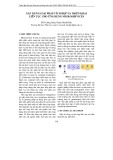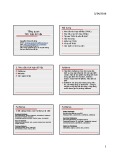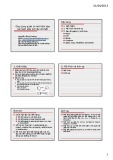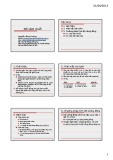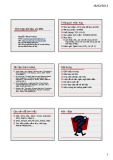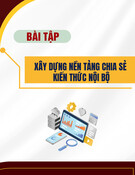
ORIGINAL ARTICLE
Facilitating digital collaboration through knowledge management: a case
study
Yawar Abbas , Alberto Martinetti , Mohammad Rajabalinejad, Florian Schuberth
and L. A. M. van Dongen
Design, Production and Management Department, University of Twente, Enschede, The Netherlands
ABSTRACT
Knowledge management (KM) can facilitate collaboration and enhance innovation. To manage
knowledge, organisations typically implement knowledge management systems (KMSs). It has
been shown that KMS facilitates the management of explicit knowledge. However, KMSs are at
times not embraced because of issues such as long file search times and information overload.
Moreover, managing tacit knowledge via KMS is hardly discussed in literature. To shed light on
these issues, this paper conducts a case study at a railway infrastructure manager. Three key
practical problems have been identified that hinder current KMS use and sharing of tacit
knowledge. To overcome these problems, a KM platform was developed, and its usability
was assessed with 17 experts. A paired-samples t-test reveals that the developed platform
reduces the file search time compared to the current solution. Moreover, structured interviews
show that the lesson-learned site component contributes to improved learning, and the KM
platform facilitates collaboration building.
ARTICLE HISTORY
Received 15 April 2021
Accepted 3 January 2022
KEYWORDS
Collaboration; integration;
lessons learned; findability;
design science research;
knowledge management
platform
1. Introduction
Both knowledge management (KM) and informa-
tion management in virtual communities of prac-
tice have taken a central spot considering the
sudden burst of working from home due to the
COVID-19 pandemic. Organisations have been
caught off guard, and the full extent of digital
working still needs to be thoroughly understood.
Fortunately, technology was prepared to facilitate
large-scale migration from a physical working
environment to digital online working. According
to McKinsey, consumer and business digital adap-
tation have moved five years ahead in just eight
weeks (Baig et al., 2020), which is transforma-
tional both in a practical business-oriented world
and on a fundamental academic level. However,
many such digital systems were not designed to be
used as a prime mode of communication and
interaction. Moreover, much tacit knowledge is
shared by spending time with each other having
close interaction and not via digital platforms.
Strong cooperation and collaboration culture
have also been advocated as a prerequisite for
effective knowledge transfer among community
members (De Lima & De Carvalho, 2007). The
ongoing transformation in ways of working trig-
gers the need to re-examine the currently used
digital platforms for KM and to identify means
of enhancing cooperation and collaboration
through these platforms.
This study sheds further light on the topic of enhan-
cing collaboration through KM by conducting a case
study at ProRail, the principal railway infrastructure
manager in the Netherlands, which is hereon referred
to as the infrastructure manager. Specifically, it explores
the current practices for KM among the test labs of the
infrastructure manager and develops a KM platform that
improves collaboration among the test lab members.
2. Theoretical background
Collaboration is defined as “[a] coordinated, synchro-
nous activity that is the result of a continued attempt
to construct and maintain a shared conception of
a problem” (Roschelle & Teasley, 1995, p. 70). It has
been studied in different contexts, such as its role in
process innovation (Ashok et al., 2016) and organisa-
tional learning (Martínez-Costa et al., 2019). In addi-
tion, several approaches and frameworks have been
proposed to enhance collaboration (see, e.g., Salisbury,
2008).
The literature shows that collaboration can be sup-
ported by KM. For instance, International Standards
Organization (ISO, 2018, p. V) states that “[e]ffective
CONTACT Yawar Abbas yawar.abbas@utwente.nl Design, Production and Management Department, University of Twente, Drienerlolaan 5,
Enschede 7500 AE, The Netherlands
Supplemental data for this article can be accessed here.
KNOWLEDGE MANAGEMENT RESEARCH & PRACTICE
2022, VOL. 20, NO. 6, 797–813
https://doi.org/10.1080/14778238.2022.2029597
© 2022 The Author(s). Published by Informa UK Limited, trading as Taylor & Francis Group.
This is an Open Access article distributed under the terms of the Creative Commons Attribution-NonCommercial-NoDerivatives License (http://creativecommons.org/licenses/by-
nc-nd/4.0/), which permits non-commercial re-use, distribution, and reproduction in any medium, provided the original work is properly cited, and is not altered, transformed, or
built upon in any way.

knowledge management supports collaboration
between different organisations to achieve shared
objectives”. Moreover, research on knowledge man-
agement systems (KMSs) has shown that shared data-
bases provide solid grounds for collaboration building
if the expectations of employees are considered when
implementing KMSs (Edith Toure et al., 2014; Yoder
et al., 1989). Similarly, the ISO emphasises that colla-
boration can be increased by organisational KM (ISO,
2018).
The method of managing organisational knowledge
depends on the nature of the knowledge (Olomolaiye
& Egbu, 2005). Two main types of organisational
knowledge are generally distinguished: explicit and
tacit knowledge (Nonaka & Von Krogh, 2009).
Explicit knowledge is knowledge that can be system-
atically stored, articulated, and shared in codified
forms, such as computer files (Chen et al., 2011).
Although definitions of tacit knowledge can widely
vary, as highlighted by Dampney et al. (2002), tacit
knowledge is commonly considered practical, action-
oriented knowledge acquired through personal experi-
ences and is seldom openly expressed (Smith, 2001).
However, as Nonaka and Von Krogh (2009) noted,
organisational tacit knowledge can be converted into
explicit and tacit knowledge through externalisation
and socialisation. For socialisation and externalisation,
several technologies have been proposed to manage
tacit knowledge, such as teleconferencing, synchro-
nous collaboration, question answering and annota-
tion, respectively (Abdullah et al., 2005). However,
there are controversial views on the feasibility and
efficacy of managing tacit knowledge through digital
means (Al-Qdah & Salim, 2013). As emphasised by
Panahi et al. (2013), there are significant theoretical
arguments for sharing tacit knowledge through digital
means, although there is currently a lack of empirical
evidence.
Against the background of the importance of KM
for supporting collaboration, it is surprising that to
date, designing KMS for managing organisational
knowledge has received little attention. For instance,
when designing a KMS, it is not clear which functions
are necessary for collaboration building and how the
expectations and experiences of the employees can be
considered. “[w]hile there is no way of ever showing
that the tacit knowledge of key workers has been
captured, a set of rules enabling reproduction of that
tacit knowledge can be established” (Gourlay, 2004,
p. 12) including metaphors and best practice.
Additionally, lessons learned have been identified as
a prominent method to learn from the experiences of
others and essential for collaborative learning (Al-
Qdah & Salim, 2013; Nino et al., 2015) and for orga-
nisational learning (McClory et al., 2017). It is empha-
sised that proper management of lessons learned
through KMS requires attention to another key design
component, i.e., the learnability of shared lessons,
which refers to the ease with which one learns from
a particular lesson (Abbas et al., 2020). Another key
KMS component that supports organisational tacit
KM is the findability of the experts in the organisation,
where findability is the ease of finding desired knowl-
edge in the available KM platforms (Abbas et al.,
2020). It can be addressed through collaborative
expert search and collaborative expert recommenda-
tion (Cha et al., 2015).
In this study, the authors focus on collaboration
building through (re-)designing KM platforms.
Specifically, the authors conduct a case study at the
infrastructure manager to explore methods to (re-)
design current KM platforms to improve the findabil-
ity and learnability of shared knowledge. Moreover,
this study responds to the call of reference for more
empirical evidence to manage tacit knowledge through
digital means. The next section provides insight into
the methodology to conduct this research.
3. Methodology
The study followed the Design Science Research
Methodology (DSRM) developed by Peffers et al.
(2007). Although the methodology was originally
developed to conduct Design Science Research in
Information Systems, the authors select this metho-
dology because of its previous use in designing KMS
(e.g., Sarnikar & Deokar, 2017). Depending on the
research problem, different possible research entry
points have been proposed to apply the DSRM. For
an elaboration of different entry points, the interested
reader is referred to Peffers et al. (2007).
In this study, the authors adopt the DSRM from the
problem-centred initiation research entry point
because they aim to develop a KM platform that
addresses the problem of collaboration building
among the test labs’ members of the infrastructure
manager. To address this problem, a KM platform is
developed, which primarily focuses on improving the
findability and learnability of shared knowledge, two
crucial KMS components for collaboration building.
The study follows a structured nominal process
sequence as proposed by Peffers et al. (2007) and
shown in Figure 1.
As shown in Figure 1, in the first step, the problem
must be identified and motivated. By juxtaposing the
test labs of the infrastructure manager in terms of their
maturity and development cycle, the authors gain
knowledge about the current state of the collaboration
problem among the test labs. Moreover, the authors
lay out the rationale for developing a KM platform to
build collaboration among test labs. In the second
step, after identifying the key practical problems of
the current solution for KM, the authors define the
objectives of the desired solution with key
798 Y. ABBAS ET AL.

stakeholders of the infrastructure manager. In the
third step, the KM platform is designed and developed
following a stepwise design and development process
based on the functionalities and architecture desired
by the test labs’ members. Next, to demonstrate and
evaluate the performance of the developed platform, it
is compared to the currently used solution in terms of
file search time and usability of the lessons learned
function. Finally, the results are communicated to the
key stakeholders of the infrastructure manager in the
form of reports and presentations.
4. Description of the infrastructure manager
case
The research was conducted at the principal railway
infrastructure manager in the Netherlands. Among
the responsibilities of the infrastructure manager are
the construction, maintenance, and management of
the Dutch railway infrastructure. It manages all train
traffic, which includes both passenger and freight
transport within the Netherlands. The infrastructure
manager develops, builds, and manages new tracks,
stations, and rail systems. Moreover, it maintains
existing tracks, points, signals, and crossings and man-
ages operational traffic control.
The Dutch Railway infrastructure is currently going
through large-scale technological transformations
such as the upgradation of catenary voltage from
1,500 volts to 3,000 volts and introduction of the
European Railway Traffic Management System
(ERTMS). To facilitate innovation, modify and replace
current infrastructure products and services, the infra-
structure manager has established a network of test
labs. These test labs use the renowned Vee model from
systems engineering for product and services integra-
tion and validation testing. As highlighted in
Section 2, collaboration through KM is crucial for
achieving shared objectives. Therefore, collaboration
among the test labs’ members must be established to
achieve shared objectives, such as smooth integration
of products and services.
To properly understand the collaboration pro-
blem, the authors depict the existing and planned
test labs in an organisational map, as shown in
Figure 2, within different departments of the infra-
structure manager.
4.1. Digital assets lab (DAL)
The Digital Assets Lab (DAL) focuses on identifying
new digital techniques to monitor the condition of
critical components of the Dutch railway infrastruc-
ture. Different critical components are available on-
site to test new methods to monitor their performance,
such as rails, switches, overhead lines, and level
crossings.
4.2. Railway lab
The Railway Lab provides a safe environment to test
different logistics and infrastructure concepts by ser-
ious games and other simulation tools. By testing such
concepts at an early stage with the end-users, the end-
users can become acquainted with the system and gain
insight into how the system will function in the opera-
tional world.
Figure 1. Conducted activities in accordance with DSRM steps proposed by Peffers et al. (2007).
KNOWLEDGE MANAGEMENT RESEARCH & PRACTICE 799

4.3. ProRail ERTMS integration (PREI) lab
The lab was established to create a test environ-
ment where various ERTMS-related tests can be
performed, and the operation of the ERTMS system
can be demonstrated. It consists of several systems:
process control systems, interfaces with train pro-
tection systems, global systems for mobile commu-
nication – railway (GSM-R) interfaces between
trains and radio block centres (RBCs), etc.
Different train tracks of the Netherlands can be
simulated in the system, and operational processes
can be tested.
4.4. EULYNX lab
The EULYNX Lab project is still in its planning
phase. It aims to standardise interfaces between
interlocking and object controller systems. The ulti-
mate objective is to develop an object controller
system that can connect all objects of the rail infra-
structure to one interlocking system. The lab is
scheduled to be operational by 2022.
4.5. Data lab
The Data Lab was established to develop innovative
solutions to prevent disruptions using data analysis
and sensors. The infrastructure manager works closely
with universities, knowledge institutions, and engi-
neering firms to develop such solutions.
4.6. ProRail test centre (PTC) lab
The lab supports and guides the testing processes of all
information communication technology (ICT) and
software-related aspects of the infrastructure manager.
This includes ICT developments related to train traffic
control and the control of signals and switches.
As indicated in Figure 2, the test labs fall under the
responsibility of three departments, each of which has
its own goals and challenges. Effective collaboration
among these test labs can aid the infrastructure man-
ager in smoothly integrating new products and ser-
vices into the Dutch railway infrastructure. All
mentioned test labs aim to improve the Dutch railway
infrastructure. As shown in Figure 3, they are in dif-
ferent phases of the development cycle and show dif-
ferent levels of maturity.
The heterogeneity of the test labs in terms of matur-
ity and development cycle implies that the sharing of
experiences and knowledge gained from integration
and validation tests across these test labs can largely
improve the management of all test labs and the entire
Dutch railway infrastructure. However, the current
connections among these test labs are far from opti-
mal, and the degree of connection among them
strongly varies. While there is an existing physical
glass fibre connection between PREI and PTC, other
test labs are not even physically connected. In addition
to physical connections, the test labs can be connected
on strategic, policy, and regulations levels, e.g., by
having a shared vision and harmonising the test
requirements.
Figure 2. Organisational mapping of the test labs.
800 Y. ABBAS ET AL.

4.7. Problem description and objectives of the
solutions
The infrastructure manager aims to improve colla-
boration among the presented test labs to facilitate
innovation and ensure a controlled implementation
of changes to the current infrastructure. To identify
a potential solution for this endeavour, a preliminary
investigation comprising concise semi structured
interviews with key stakeholders of the infrastructure
manager was conducted. As an outcome, two potential
solutions were identified:
(1) Organisational restructuring of the test labs
(2) Development of a KM platform
Research on organisational structure for collaboration
has shown that both separate and joint departments
can lead to high-performing organisations (Le
Meunier-Fitzhugh & Piercy, 2008). Therefore, restruc-
turing the six test labs, which currently fall under the
responsibility of three departments (see Figure 2), into
one department may be a solution for the infrastruc-
ture manager to improve collaboration. However, the
preliminary investigations reveal that restructuring
the test labs into one department has little organisa-
tional support.
Considering the development of a KM platform,
the literature has shown that KM plays a central
role in innovation (Du Plessis, 2007), and KM
platforms significantly improve corporate innova-
tion capabilities (Quan et al., 2020). Moreover,
successful KM projects can enhance collaboration
among employees (Campbell & Brown, 2012).
Therefore, a second solution to enhance collabora-
tion among the test labs’ members and facilitate
innovation is the development of a KM platform
without a restructuring of the organisation of the
test labs.
The preliminary investigation of the current
situation reveals that for KM, the employees of the
infrastructure manager mostly use Microsoft
SharePoint, Microsoft OneDrive, personal hard
drives, email, and L-drive (i.e., a company-wide
document storage space that runs on a local area
network). However, there is no unified KM platform
for collaboration among the test labs’ members.
Initially, the L-drive was the predominant document
management system. The L-drive followed
a structured approach of storing relevant informa-
tion (with proper version descriptions and access
rights) and forced employees to often navigate
through five or more layers to access a specific file,
which made it difficult for the employees of the
infrastructure manager to easily access files in
a time-efficient manner. To address this issue, the
infrastructure manager introduced Microsoft
SharePoint as a replacement to the L-drive, which
should be used as the de facto KMS.
The use of Microsoft SharePoint was low among
the employees of the infrastructure manager, and
consequently, the objective of its introduction was
not achieved. The preliminary investigation showed
that most employees still use either their personal
drives or the L-drive for KM. This is mainly because
they are more used to old ways of working, and each
test lab individually uses Microsoft SharePoint and
not as a unified platform for all test labs. Employees
have experienced a poor structure and lack under-
standing of how to properly use Microsoft
SharePoint, which results in long search time. In
Figure 3. Test labs maturity vs. development cycle phase.
KNOWLEDGE MANAGEMENT RESEARCH & PRACTICE 801

